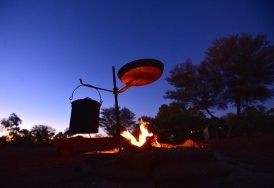As regular visitors to the Darling River area in western New South Wales it was hard not to notice on our most recent visit how much the river level has gone down over the past few months.
Many Australian outback travellers will be familiar with the section of the river from Bourke to Menindee which is an enjoyable drive and a great way to spend a week or two. Just meandering across the far-reaching plains on the dusty track that follows the Darling…
Recently we spent a few days alongside the Darling at Trilby Station, a large sheep station not too far from the river port of Louth. Its owners, Gary and Liz are welcoming hosts and the Murray family can trace their settlement on the river back six generations to 1860 – truly, a pioneering family!
In days long gone river boats gently steamed their way from the coast to Bourke, their owners’ plying trade and carrying much needed supplies to the small communities that were established at varying intervals along the river. On the return journey, loaded with bales of wool, the boats were gracefully navigated to the sea port situated a long way from the dusty and, at times, desolate interior.
I am sure many will remember the Australian mini-television series “All the Rivers Run” that was based on the novel by Nancy Cato. Whilst it was centered around the Murray River, daily life on the Darling would have been much the same.
As my kayak gently rocked in the shallow waters on a cooling breeze, the sound of the rustling leaves on the river gums transported me to another time as I drifted downstream from our camp. I could hear the laughter of people long-gone, the toil of the boat crews ensuring the boiler had a head-of-steam, and the gentle sound of the paddle on the steamers as their river boat captains navigated their way along the river, skilfully and carefully avoiding hidden and submerged obstacles…
In times of drought and lack of rains further north many boats were trapped as the river turned into a series of water-holes as it dried up. Although in the days of the River Boat the Darling flowed far more freely than it does today as there were no weirs to hinder the gentle flow of the water, no cotton farms sucking the life from it or the surrounding country that depends on its precious water for survival.
Cotton farming arrived into the region in the 1960s after the Boon and Buster families established themselves in and around Bourke.
The fifty years since that time has seen a steady decay of the Darling and the greater Murray-Darling basin. One has to question the wisdom of growing cotton on the world’s driest continent at the expense of degrading the water in our rivers – some will rightly call it vandalism.
I am a avid student of aboriginal culture and histories, striving to read, learn and listen to as much as I am able to absorb. In April 2010, aboriginal people whose traditional areas border the Darling, Macquarie and Bogan catchment areas formed a group to ensure their views on river management were heard.
The following quote from Phil Sullivan, an Ngemba traditional owner, struck a resonance with me and perhaps it will with others.
“Water to me is the essence of life. And I’ve got to respect life, and I’ve got to honour life. If I don’t honour it and look after it, then it’s going to take my life away from me. It’s going to take the very essence of who I am away from me.
So that’s why I honour the river, the water, and give respect to it. Because in the end if I don’t look after that… then me and my family and my tribe and the gift that’s been given to us is going to be whittled away.
I got to give honour and I got to give respect to that, first and foremost. And then everything else will fall into place. It’s like a bit of a foundation.” 
The Darling River should be treated as a natural treasure for all, not dammed with weirs so the water can be whittled away on an agriculture crop that may have some economic value, but a huge environmental cost.
Whether visiting for the first time or returning to explore further, take your time and enjoy the Darling, a mighty river that breathes life into a parched and ancient land…
Cheers, Baz – The Landy





I like that thought of hearing laughter and sounds of people long gone. Land does speak, and voices travel on starlight.
Water usage is a serious issue here as well. There is a good article in High country News on the Snake River
https://www.hcn.org/issues/46.13/idahos-sewer-system-is-the-snake-river
LikeLike
Thanks for sharing Lavinia…Baz
LikeLike
Apparently the paddle steamers once made it to Mungindi at the head of the Barwon River as well. Couldn’t see that happening these days.
LikeLike
Thanks, that doesn’t surprise me, but you are right, can’t get too far these days due to the weirs…
LikeLike
Great article, Baz. I’d love to go there – another item on my bucket list that has a big hole in it.
I am with you all the way on the importance of the Darling and the sheer stupidity of growing cotton in such a dry climate.
LikeLike
Be sure to visit, a wonderful area…starting from Bourke and heading south-west along the river! Cheers, Baz
LikeLiked by 1 person
Oh this makes me miss regional and remote parts of Australia so much! Amazing photos
LikeLiked by 1 person
Oh well, pop home for a while, enjoy 😉
LikeLiked by 1 person